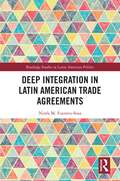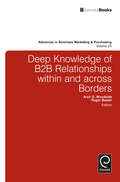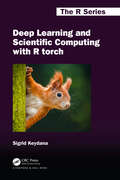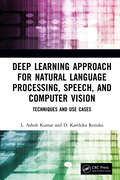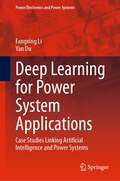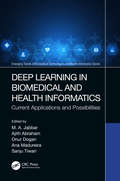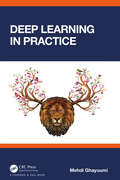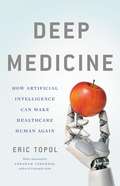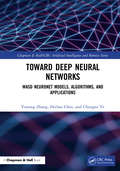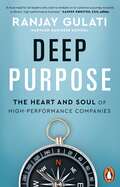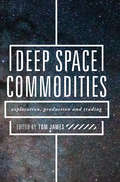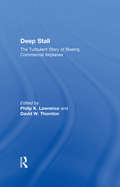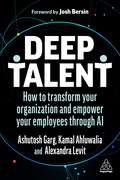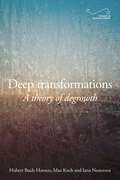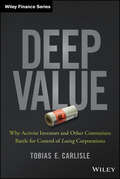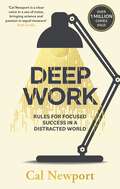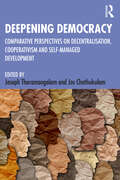- Table View
- List View
Deep Integration in Latin American Trade Agreements (Routledge Studies in Latin American Politics)
by Ninfa M. Fuentes-SosaTrade agreements have uncontested relevance as essential instruments governing international trade, yet little attention has been directed towards explaining differences in their content. Deep Integration in Latin American Trade Agreements analyzes the structure, nature, and characteristics of deep integration in trade agreements established by Latin American countries after the crises of 1982 and until 2020 with their regional and extra-regional partners. Ninfa M. Fuentes-Sosa argues that deep integration can be disaggregated into its institutional, operative, and horizontal dimensions (which differ regarding their functions and application level). Empirically, she demonstrates that trade provisions can be mapped, measured, and allocated into their corresponding dimension, providing an understanding of the deep integration structure in Latin America. She claims that the current structure poses challenges for deepening regionalism at a broad scale. Countries working on specific areas over time could diminish obstacles that have prevented them from achieving deeper trade integration. Providing an operational definition and measures of deep integration, this book will be of great interest to scholars, graduate students, and policymakers working in the field of international political economy, trade, and trade politics.
Deep Knowledge of B2B Relationships Within and Across Borders (Advances in Business Marketing and Purchasing #20)
by Arch G. Woodside Roger BaxterRelationships of individual and groups among three-plus firms represent the cornerstone concept in business-to-business (B2B) contexts. The three-plus firms include manufacturer-supplier to manufacturer-customer to distributor-customer, and facilitators (e.g., transportation and management consulting firms). The common thread of the five papers in this volume is that making sense and achieving deep knowledge of three-plus B2B relationships are necessary antecedents for achieving high operating effectiveness, high (on-time) efficiency, and sustaining profits for each firm in these relationships. As the titles of the five papers imply, reading the volume provides deep insights into the specifics of how high performing three-plus B2B relationships influences these three major objectives of the firm: National Cultures? Impacts on Western Industrial Buyer-Seller Relational Process Models; Developing Guanxi Relations; Industrial Buyer-Seller Relations in a Chinese Context; Adaptation in Business Contexts; Working Triadic Relationships; How Do Managers See It? Capturing Practitioner Theories via Network Pictures.
Deep Learning and Scientific Computing with R torch (Chapman & Hall/CRC The R Series)
by Sigrid Keydanatorch is an R port of PyTorch, one of the two most-employed deep learning frameworks in industry and research. It is also an excellent tool to use in scientific computations. It is written entirely in R and C/C++. Though still "young" as a project, R torch already has a vibrant community of users and developers. Experience shows that torch users come from a broad range of different backgrounds. This book aims to be useful to (almost) everyone. Globally speaking, its purposes are threefold: - Provide a thorough introduction to torch basics – both by carefully explaining underlying concepts and ideas, and showing enough examples for the reader to become "fluent" in torch. - Again with a focus on conceptual explanation, show how to use torch in deep-learning applications, ranging from image recognition over time series prediction to audio classification. - Provide a concepts-first, reader-friendly introduction to selected scientific-computation topics (namely, matrix computations, the Discrete Fourier Transform, and wavelets), all accompanied by torch code you can play with. Deep Learning and Scientific Computing with R torch is written with first-hand technical expertise and in an engaging, fun-to-read way.
Deep Learning and Scientific Computing with R torch (Chapman & Hall/CRC The R Series)
by Sigrid Keydanatorch is an R port of PyTorch, one of the two most-employed deep learning frameworks in industry and research. It is also an excellent tool to use in scientific computations. It is written entirely in R and C/C++. Though still "young" as a project, R torch already has a vibrant community of users and developers. Experience shows that torch users come from a broad range of different backgrounds. This book aims to be useful to (almost) everyone. Globally speaking, its purposes are threefold: - Provide a thorough introduction to torch basics – both by carefully explaining underlying concepts and ideas, and showing enough examples for the reader to become "fluent" in torch. - Again with a focus on conceptual explanation, show how to use torch in deep-learning applications, ranging from image recognition over time series prediction to audio classification. - Provide a concepts-first, reader-friendly introduction to selected scientific-computation topics (namely, matrix computations, the Discrete Fourier Transform, and wavelets), all accompanied by torch code you can play with. Deep Learning and Scientific Computing with R torch is written with first-hand technical expertise and in an engaging, fun-to-read way.
Deep Learning Approach for Natural Language Processing, Speech, and Computer Vision: Techniques and Use Cases
by L. Ashok Kumar D. Karthika RenukaDeep Learning Approach for Natural Language Processing, Speech, and Computer Vision provides an overview of general deep learning methodology and its applications of natural language processing (NLP), speech and computer vision tasks. It simplifies and presents the concepts of deep learning in a comprehensive manner, with suitable, full-fledged examples of deep learning models, with an aim to bridge the gap between the theory and the applications using case studies with code, experiments, and supporting analysis. Features: Covers latest developments in deep learning techniques as applied to audio analysis, computer vision, and NLP Introduces contemporary applications of deep learning techniques as applied to audio, textual, and visual processing Discovers deep learning frameworks and libraries for NLP, speech and computer vision in Python Gives insights into using the tools and libraries in Python for real-world applications. Provides easily accessible tutorials, and real-world case studies with codes to provide hands-on experience. This book is aimed at researchers and graduate students in computer engineering, image, speech, and text processing.
Deep Learning Approach for Natural Language Processing, Speech, and Computer Vision: Techniques and Use Cases
by L. Ashok Kumar D. Karthika RenukaDeep Learning Approach for Natural Language Processing, Speech, and Computer Vision provides an overview of general deep learning methodology and its applications of natural language processing (NLP), speech and computer vision tasks. It simplifies and presents the concepts of deep learning in a comprehensive manner, with suitable, full-fledged examples of deep learning models, with an aim to bridge the gap between the theory and the applications using case studies with code, experiments, and supporting analysis. Features: Covers latest developments in deep learning techniques as applied to audio analysis, computer vision, and NLP Introduces contemporary applications of deep learning techniques as applied to audio, textual, and visual processing Discovers deep learning frameworks and libraries for NLP, speech and computer vision in Python Gives insights into using the tools and libraries in Python for real-world applications. Provides easily accessible tutorials, and real-world case studies with codes to provide hands-on experience. This book is aimed at researchers and graduate students in computer engineering, image, speech, and text processing.
Deep Learning for Power System Applications: Case Studies Linking Artificial Intelligence and Power Systems (Power Electronics and Power Systems)
by Fangxing Li Yan DuThis book provides readers with an in-depth review of deep learning-based techniques and discusses how they can benefit power system applications. Representative case studies of deep learning techniques in power systems are investigated and discussed, including convolutional neural networks (CNN) for power system security screening and cascading failure assessment, deep neural networks (DNN) for demand response management, and deep reinforcement learning (deep RL) for heating, ventilation, and air conditioning (HVAC) control.Deep Learning for Power System Applications: Case Studies Linking Artificial Intelligence and Power Systems is an ideal resource for professors, students, and industrial and government researchers in power systems, as well as practicing engineers and AI researchers.Provides a history of AI in power grid operation and planning;Introduces deep learning algorithms and applications in power systems;Includes several representative case studies.
Deep Learning in Biomedical and Health Informatics: Current Applications and Possibilities (Emerging Trends in Biomedical Technologies and Health informatics)
by M. A. Jabbar Ajith Abraham Onur Dogan Ana Maria Madureira Sanju TiwariThis book provides a proficient guide on the relationship between Artificial Intelligence (AI) and healthcare and how AI is changing all aspects of the healthcare industry. It also covers how deep learning will help in diagnosis and the prediction of disease spread. The editors present a comprehensive review of research applying deep learning in health informatics in the fields of medical imaging, electronic health records, genomics, and sensing, and highlights various challenges in applying deep learning in health care. This book also includes applications and case studies across all areas of AI in healthcare data. The editors also aim to provide new theories, techniques, developments, and applications of deep learning, and to solve emerging problems in healthcare and other domains. This book is intended for computer scientists, biomedical engineers, and healthcare professionals researching and developing deep learning techniques. In short, the volume : Discusses the relationship between AI and healthcare, and how AI is changing the health care industry. Considers uses of deep learning in diagnosis and prediction of disease spread. Presents a comprehensive review of research applying deep learning in health informatics across multiple fields. Highlights challenges in applying deep learning in the field. Promotes research in ddeep llearning application in understanding the biomedical process. Dr.. M.A. Jabbar is a professor and Head of the Department AI&ML, Vardhaman College of Engineering, Hyderabad, Telangana, India. Prof. (Dr.) Ajith Abraham is the Director of Machine Intelligence Research Labs (MIR Labs), Auburn, Washington, USA. Dr.. Onur Dogan is an assistant professor at İzmir Bakırçay University, Turkey. Prof. Dr. Ana Madureira is the Director of The Interdisciplinary Studies Research Center at Instituto Superior de Engenharia do Porto (ISEP), Portugal. Dr.. Sanju Tiwari is a senior researcher at Universidad Autonoma de Tamaulipas, Mexico.
Deep Learning in Biomedical and Health Informatics: Current Applications and Possibilities (Emerging Trends in Biomedical Technologies and Health informatics #68)
by M. A. Jabbar Ajith Abraham Onur Dogan Ana Madureira Sanju TiwariThis book provides a proficient guide on the relationship between Artificial Intelligence (AI) and healthcare and how AI is changing all aspects of the healthcare industry. It also covers how deep learning will help in diagnosis and the prediction of disease spread. The editors present a comprehensive review of research applying deep learning in health informatics in the fields of medical imaging, electronic health records, genomics, and sensing, and highlights various challenges in applying deep learning in health care. This book also includes applications and case studies across all areas of AI in healthcare data. The editors also aim to provide new theories, techniques, developments, and applications of deep learning, and to solve emerging problems in healthcare and other domains. This book is intended for computer scientists, biomedical engineers, and healthcare professionals researching and developing deep learning techniques. In short, the volume : Discusses the relationship between AI and healthcare, and how AI is changing the health care industry. Considers uses of deep learning in diagnosis and prediction of disease spread. Presents a comprehensive review of research applying deep learning in health informatics across multiple fields. Highlights challenges in applying deep learning in the field. Promotes research in ddeep llearning application in understanding the biomedical process. Dr.. M.A. Jabbar is a professor and Head of the Department AI&ML, Vardhaman College of Engineering, Hyderabad, Telangana, India. Prof. (Dr.) Ajith Abraham is the Director of Machine Intelligence Research Labs (MIR Labs), Auburn, Washington, USA. Dr.. Onur Dogan is an assistant professor at İzmir Bakırçay University, Turkey. Prof. Dr. Ana Madureira is the Director of The Interdisciplinary Studies Research Center at Instituto Superior de Engenharia do Porto (ISEP), Portugal. Dr.. Sanju Tiwari is a senior researcher at Universidad Autonoma de Tamaulipas, Mexico.
Deep Learning in Practice
by Mehdi GhayoumiDeep Learning in Practice helps you learn how to develop and optimize a model for your projects using Deep Learning (DL) methods and architectures. Key features: Demonstrates a quick review on Python, NumPy, and TensorFlow fundamentals. Explains and provides examples of deploying TensorFlow and Keras in several projects. Explains the fundamentals of Artificial Neural Networks (ANNs). Presents several examples and applications of ANNs. Learning the most popular DL algorithms features. Explains and provides examples for the DL algorithms that are presented in this book. Analyzes the DL network’s parameter and hyperparameters. Reviews state-of-the-art DL examples. Necessary and main steps for DL modeling. Implements a Virtual Assistant Robot (VAR) using DL methods. Necessary and fundamental information to choose a proper DL algorithm. Gives instructions to learn how to optimize your DL model IN PRACTICE. This book is useful for undergraduate and graduate students, as well as practitioners in industry and academia. It will serve as a useful reference for learning deep learning fundamentals and implementing a deep learning model for any project, step by step.
Deep Learning in Practice
by Mehdi GhayoumiDeep Learning in Practice helps you learn how to develop and optimize a model for your projects using Deep Learning (DL) methods and architectures. Key features: Demonstrates a quick review on Python, NumPy, and TensorFlow fundamentals. Explains and provides examples of deploying TensorFlow and Keras in several projects. Explains the fundamentals of Artificial Neural Networks (ANNs). Presents several examples and applications of ANNs. Learning the most popular DL algorithms features. Explains and provides examples for the DL algorithms that are presented in this book. Analyzes the DL network’s parameter and hyperparameters. Reviews state-of-the-art DL examples. Necessary and main steps for DL modeling. Implements a Virtual Assistant Robot (VAR) using DL methods. Necessary and fundamental information to choose a proper DL algorithm. Gives instructions to learn how to optimize your DL model IN PRACTICE. This book is useful for undergraduate and graduate students, as well as practitioners in industry and academia. It will serve as a useful reference for learning deep learning fundamentals and implementing a deep learning model for any project, step by step.
Deep Medicine: How Artificial Intelligence Can Make Healthcare Human Again
by Eric TopolA Science Friday pick for book of the year, 2019One of America's top doctors reveals how AI will empower physicians and revolutionize patient care Medicine has become inhuman, to disastrous effect. The doctor-patient relationship--the heart of medicine--is broken: doctors are too distracted and overwhelmed to truly connect with their patients, and medical errors and misdiagnoses abound. In Deep Medicine, leading physician Eric Topol reveals how artificial intelligence can help. AI has the potential to transform everything doctors do, from notetaking and medical scans to diagnosis and treatment, greatly cutting down the cost of medicine and reducing human mortality. By freeing physicians from the tasks that interfere with human connection, AI will create space for the real healing that takes place between a doctor who can listen and a patient who needs to be heard. Innovative, provocative, and hopeful, Deep Medicine shows us how the awesome power of AI can make medicine better, for all the humans involved.
Deep Neural Networks: WASD Neuronet Models, Algorithms, and Applications (Chapman & Hall/CRC Artificial Intelligence and Robotics Series)
by Yunong Zhang Dechao Chen Chengxu YeToward Deep Neural Networks: WASD Neuronet Models, Algorithms, and Applications introduces the outlook and extension toward deep neural networks, with a focus on the weights-and-structure determination (WASD) algorithm. Based on the authors’ 20 years of research experience on neuronets, the book explores the models, algorithms, and applications of the WASD neuronet, and allows reader to extend the techniques in the book to solve scientific and engineering problems. The book will be of interest to engineers, senior undergraduates, postgraduates, and researchers in the fields of neuronets, computer mathematics, computer science, artificial intelligence, numerical algorithms, optimization, simulation and modeling, deep learning, and data mining. Features Focuses on neuronet models, algorithms, and applications Designs, constructs, develops, analyzes, simulates and compares various WASD neuronet models, such as single-input WASD neuronet models, two-input WASD neuronet models, three-input WASD neuronet models, and general multi-input WASD neuronet models for function data approximations Includes real-world applications, such as population prediction Provides complete mathematical foundations, such as Weierstrass approximation, Bernstein polynomial approximation, Taylor polynomial approximation, and multivariate function approximation, exploring the close integration of mathematics (i.e., function approximation theories) and computers (e.g., computer algorithms) Utilizes the authors' 20 years of research on neuronets
Deep Purpose: The Heart and Soul of High-Performance Companies
by Ranjay Gulati'If you want to be inspired to build more sustainable organizations, Deep Purpose should be your next read' Arianna Huffington, Founder & CEO, Thrive Global'Insightful, practical, and timely' Adam Grant, #1 New York Times bestselling author of Think Again and host of the TED podcast WorkLife'Deep Purpose points to the conversations we must have right now about how to redefine the role of business in society, restore trust, and enhance our license to operate ... Highly recommended' Paul Polman, former CEO, Unilever--------------Distinguished Harvard Business School professor Ranjay Gulati takes readers inside some of the world's most purposeful companies to understand the secrets to their successFew business topics have aroused more skepticism in recent years than the notion of corporate purpose, and for good reason. Too many companies deploy purpose as a promotional vehicle to make themselves feel virtuous and to look good to the outside world. Some have only foggy ideas about what purpose is and conflate it with strategy and other concepts like 'mission', 'vision' and 'values'. Even well-intentioned leaders don't understand purpose's full potential and engage with it half-heartedly and superficially. Having conducted extensive field research and interviewed leadership at purpose-oriented companies including Etsy, Lego and Microsoft, Ranjay Gulati reveals the fatal mistakes leaders unwittingly make when attempting to implement a reason for being. Moreover, he shows how companies can embed purpose much more deeply, delivering impressive performance benefits that reward customers, suppliers, employees, shareholders and communities alike. To get this right, leaders must fundamentally change not only how they execute purpose but also how they conceive of and relate to it. They must practice what Gulati calls deep purpose, furthering each organisation's reason for being more intensely, thoughtfully and comprehensively than ever before.As he argues, a deeper engagement with purpose can serve as a radically new operating system, enhancing performance while also delivering meaningful benefits to society. It's the kind of inspired thinking that businesses - and the rest of us - urgently need.--------------- 'Purpose isn't a "nice-to-have" in the business world anymore. It's a "must-have". This comprehensive guide breaks down why cultivating purpose isn't just the right thing for businesses to do - it's the smart thing too.' Carmine Di Sibio, Global Chairman and CEO, EY'Many leaders today strive to align purpose with financial success, but only a few succeed. Gulati analyzes the tough challenges that leaders everywhere must address if they are to save the planet while also delivering strong profits.' Toshiaki Higashihara, Executive Chairman & CEO, Hitachi, Ltd.
Deep Space Commodities: Exploration, Production and Trading
by Tom JamesWelcome to the new space economy... Space is open for business! The dawn of a new space race led by private sector entrepreneurs is upon us thanks to the USA Space Act 2015 and technology advances like SpaceX rockets, which have greatly reduced the cost of space flight. For the first time in history, the advances in both technical and legal infrastructure have opened up exciting opportunities that are already driving the commercial exploration of deep space commodities, Space tourism with Virgin Galactic, and the serious planning for the colonisation of our Moon and Mars. Tom James, a leading commodity and energy market practitioner and author, has brought together top professionals in academia, astropolitics, space engineering, and space law to explore the exciting opportunities and challenges businesses face in the new off-planet economy. With quadrillions of dollars of mineral wealth and frozen water within our reach, the stakes may be high, but so are the rewards.So pack your bags, fasten your oxygen mask and let’s get ready to boldly take business where business has not gone before...
Deep Space Commodities: Exploration, Production and Trading
by Tom JamesWelcome to the new space economy... Space is open for business! The dawn of a new space race led by private sector entrepreneurs is upon us thanks to the USA Space Act 2015 and technology advances like SpaceX rockets, which have greatly reduced the cost of space flight. For the first time in history, the advances in both technical and legal infrastructure have opened up exciting opportunities that are already driving the commercial exploration of deep space commodities, Space tourism with Virgin Galactic, and the serious planning for the colonisation of our Moon and Mars. Tom James, a leading commodity and energy market practitioner and author, has brought together top professionals in academia, astropolitics, space engineering, and space law to explore the exciting opportunities and challenges businesses face in the new off-planet economy. With quadrillions of dollars of mineral wealth and frozen water within our reach, the stakes may be high, but so are the rewards.So pack your bags, fasten your oxygen mask and let’s get ready to boldly take business where business has not gone before...
Deep Stall: The Turbulent Story of Boeing Commercial Airplanes
by Philip K. Lawrence David W. ThorntonDeep Stall applies a framework of strategic analysis to the Boeing Company. Boeing is the world's largest aerospace / defence company, with turnover in the region of US $60bn. The book examines the relative decline of Boeing in the civil aircraft market in relation to European manufacturer, Airbus. The aim of the book is to utilize the concept of strategic value to explain Boeing's decline. The authors define this concept as investment in people and technology to leverage future market success by developing innovative new products, arguing that Boeing has neglected strategic value in favour of shareholder value, defined in terms of short-term cash benefits. The rationale for the book exists both in the fact that the story in itself is interesting and also in the wider framework of analysis concerning the correct strategic approach for running a high technology business. The argument illustrates what can happen when quarterly returns become the predominant strategic rationale for a company. In the U.S. the business media (Economist, Forbes, Fortune, and Business Week etc) are now focusing on the question of Boeing's decline and the major implications for the U.S. national interest. Boeing is one of the jewels in the US technology crown, but today U.S. jobs and capability are being exported abroad, with most of its aircraft program work based in Asia. This is a hot topic in the US which explains why the business media are now so interested in this question. The book sits squarely in the centre of this debate. Deep Stall concludes with a brief analysis of the recent fight-back that has been evident in Boeing's fortunes and the successful campaign to sell the new 787. The authors probe the question of whether Airbus or Boeing is likely to dominate in the next ten or fifteen years.
Deep Stall: The Turbulent Story of Boeing Commercial Airplanes
by Philip K. Lawrence David W. ThorntonDeep Stall applies a framework of strategic analysis to the Boeing Company. Boeing is the world's largest aerospace / defence company, with turnover in the region of US $60bn. The book examines the relative decline of Boeing in the civil aircraft market in relation to European manufacturer, Airbus. The aim of the book is to utilize the concept of strategic value to explain Boeing's decline. The authors define this concept as investment in people and technology to leverage future market success by developing innovative new products, arguing that Boeing has neglected strategic value in favour of shareholder value, defined in terms of short-term cash benefits. The rationale for the book exists both in the fact that the story in itself is interesting and also in the wider framework of analysis concerning the correct strategic approach for running a high technology business. The argument illustrates what can happen when quarterly returns become the predominant strategic rationale for a company. In the U.S. the business media (Economist, Forbes, Fortune, and Business Week etc) are now focusing on the question of Boeing's decline and the major implications for the U.S. national interest. Boeing is one of the jewels in the US technology crown, but today U.S. jobs and capability are being exported abroad, with most of its aircraft program work based in Asia. This is a hot topic in the US which explains why the business media are now so interested in this question. The book sits squarely in the centre of this debate. Deep Stall concludes with a brief analysis of the recent fight-back that has been evident in Boeing's fortunes and the successful campaign to sell the new 787. The authors probe the question of whether Airbus or Boeing is likely to dominate in the next ten or fifteen years.
Deep Talent: How to Transform Your Organization and Empower Your Employees Through AI
by Alexandra Levit Ashutosh Garg Kamal AhluwaliaWhat's the secret to finding the right person for the job? And how do you ensure your existing employees thrive and flourish in the workplace? Deep Talent answers these questions and more, as it demonstrates how AI platforms can help you positively transform your business.Every successful business relies upon an effective workplace culture with employees that are driven, productive and knowledgeable. So it's vital that leaders do everything they can to hire, develop and keep the people who are driving their growth and help them recognize their skills, capabilities and potential. Deep Talent provides strategies and approaches that any business leader can adopt to reinvigorate their workforce. It highlights the rising significance of talent intelligence platforms which, when combined with human instinct, can streamline and enhance business practices.The recent transformation in workplace culture presents a huge opportunity for ambitious business leaders who want to improve their workplace culture and get ahead of the competition. Drawing upon fascinating case studies and first-hand research, Deep Talent provides clear strategies for supporting your workforce and using AI to its full potential. Uncover the cutting-edge ways in which you can reinvigorate the enthusiasm and productivity of your workforce and attract the best talent to your organization.
Deep transformations: A theory of degrowth (Progress in Political Economy)
by Hubert Buch-Hansen Max Koch Iana NesterovaAs a research field, social movement and political project, degrowth is a multi-faceted phenomenon. It brings together a range of practices including alternative forms of living and initiatives of various kinds in civil society, business and the state. Yet no comprehensive theory of degrowth transformations has so far been developed. Deep transformations fills this gap. It develops a theory of degrowth transformations drawing on insights from multiple fields of knowledge, such as political economy, sociology and philosophy. The book offers a holistic perspective that brings into focus transformation processes on various scales and points to various mechanisms that can facilitate degrowth. These for instance include ecosocial policies, transformative initiatives in business and civil society, and alternative modes of being in and relating to the world.
Deep transformations: A theory of degrowth (Progress in Political Economy)
by Hubert Buch-Hansen Max Koch Iana NesterovaAs a research field, social movement and political project, degrowth is a multi-faceted phenomenon. It brings together a range of practices including alternative forms of living and initiatives of various kinds in civil society, business and the state. Yet no comprehensive theory of degrowth transformations has so far been developed. Deep transformations fills this gap. It develops a theory of degrowth transformations drawing on insights from multiple fields of knowledge, such as political economy, sociology and philosophy. The book offers a holistic perspective that brings into focus transformation processes on various scales and points to various mechanisms that can facilitate degrowth. These for instance include ecosocial policies, transformative initiatives in business and civil society, and alternative modes of being in and relating to the world.
Deep Value: Why Activist Investors and Other Contrarians Battle for Control of Losing Corporations (Wiley Finance)
by Tobias E. CarlisleThe economic climate is ripe for another golden age of shareholder activism Deep Value: Why Activist Investors and Other Contrarians Battle for Control of Losing Corporations is a must-read exploration of deep value investment strategy, describing the evolution of the theories of valuation and shareholder activism from Graham to Icahn and beyond. The book combines engaging anecdotes with industry research to illustrate the principles and methods of this complex strategy, and explains the reasoning behind seemingly incomprehensible activist maneuvers. Written by an active value investor, Deep Value provides an insider's perspective on shareholder activist strategies in a format accessible to both professional investors and laypeople. The Deep Value investment philosophy as described by Graham initially identified targets by their discount to liquidation value. This approach was extremely effective, but those opportunities are few and far between in the modern market, forcing activists to adapt. Current activists assess value from a much broader palate, and exploit a much wider range of tools to achieve their goals. Deep Value enumerates and expands upon the resources and strategies available to value investors today, and describes how the economic climate is allowing value investing to re-emerge. Topics include: Target identification, and determining the most advantageous ends Strategies and tactics of effective activism Unseating management and fomenting change Eyeing conditions for the next M&A boom Activist hedge funds have been quiet since the early 2000s, but economic conditions, shareholder sentiment, and available opportunities are creating a fertile environment for another golden age of activism. Deep Value: Why Activist Investors and Other Contrarians Battle for Control of Losing Corporations provides the in-depth information investors need to get up to speed before getting left behind.
Deep Value: Why Activist Investors and Other Contrarians Battle for Control of Losing Corporations (Wiley Finance)
by Tobias E. CarlisleThe economic climate is ripe for another golden age of shareholder activism Deep Value: Why Activist Investors and Other Contrarians Battle for Control of Losing Corporations is a must-read exploration of deep value investment strategy, describing the evolution of the theories of valuation and shareholder activism from Graham to Icahn and beyond. The book combines engaging anecdotes with industry research to illustrate the principles and methods of this complex strategy, and explains the reasoning behind seemingly incomprehensible activist maneuvers. Written by an active value investor, Deep Value provides an insider's perspective on shareholder activist strategies in a format accessible to both professional investors and laypeople. The Deep Value investment philosophy as described by Graham initially identified targets by their discount to liquidation value. This approach was extremely effective, but those opportunities are few and far between in the modern market, forcing activists to adapt. Current activists assess value from a much broader palate, and exploit a much wider range of tools to achieve their goals. Deep Value enumerates and expands upon the resources and strategies available to value investors today, and describes how the economic climate is allowing value investing to re-emerge. Topics include: Target identification, and determining the most advantageous ends Strategies and tactics of effective activism Unseating management and fomenting change Eyeing conditions for the next M&A boom Activist hedge funds have been quiet since the early 2000s, but economic conditions, shareholder sentiment, and available opportunities are creating a fertile environment for another golden age of activism. Deep Value: Why Activist Investors and Other Contrarians Battle for Control of Losing Corporations provides the in-depth information investors need to get up to speed before getting left behind.
Deep Work: Rules for Focused Success in a Distracted World
by Cal NewportOne of the most valuable skills in our economy is becoming increasingly rare. If you master this skill, you'll achieve extraordinary results.Deep Work is an indispensable guide to anyone seeking focused success in a distracted world.'Deep work' is the ability to focus without distraction on a cognitively demanding task. Coined by author and professor Cal Newport on his popular blog Study Hacks, deep work will make you better at what you do, let you achieve more in less time and provide the sense of true fulfilment that comes from the mastery of a skill. In short, deep work is like a superpower in our increasingly competitive economy.And yet most people, whether knowledge workers in noisy open-plan offices or creatives struggling to sharpen their vision, have lost the ability to go deep - spending their days instead in a frantic blur of email and social media, not even realising there's a better way.A mix of cultural criticism and actionable advice, DEEP WORK takes the reader on a journey through memorable stories -- from Carl Jung building a stone tower in the woods to focus his mind, to a social media pioneer buying a round-trip business class ticket to Tokyo to write a book free from distraction in the air -- and surprising suggestions, such as the claim that most serious professionals should quit social media and that you should practice being bored. Put simply: developing and cultivating a deep work practice is one of the best decisions you can make in an increasingly distracted world and this book will point the way.
Deepening Democracy: Comparative Perspectives on Decentralization, Cooperativism and Self-Managed Development
by Joseph Tharamangalam and Jos ChathukulamThis book examines the renewed interest and commitment that countries across the world have shown in recent decades towards adopting models of decentralising, or "downsizing" the state, and moving towards more participatory models of government. It examines systems of decentralised development such as self-managing co-operatives from a global and comparative perspective with a focus on developing countries. Drawing on examples from Kerala and a few other states in India, as well as Cuba, Bangladesh and South Africa among other countries, the book offers critical perspectives on the positive impacts of these experiments and the promises these offer for the future. It discusses the challenges of implementing these models, how well these work in coordination with the civil society and the state, issues of transparency and democratic oversight as well as corruption and capture of power due to entrenched structures of inequality. The volume analyses welfare and development models and self-management interventionsin countering the effects of the COVID-19 pandemic. It also looks at the meritsand demerits of decentralisation in countering the global socioeconomic and environmental crisis and the rise of authoritarian populism in many countries. The book will be of interest to students and researchers of development studies, political science, business, community development, social justice as well as of co-operative management programmes. It will also appeal to students of political economy as well as development professionals, think tanks and policymakers.
